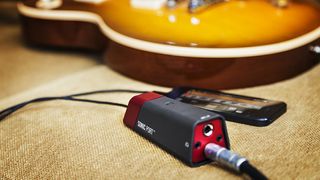Line 6 has followed up its Mobile In iOS audio interface with a more advanced offering, the Sonic Port. This CoreAudio-compatible device connects to your iDevice's Lightning port or 30-pin dock connector and promises "best-in-class" sound quality.
Designed for guitarists, this compact interface is designed to partner with the Mobile Pod multi-effects app, which comes with over 10,000 presets. It's also compatible with Jammit, an app that enables you to play along with multi-track master recordings from "major artists".
Connectivity options comprise a 1/4-inch guitar input, 1/8-inch stereo line input, 1/4-inch guitar/line output and a 1/8-inch headphones output.
Find out more in the press release below or on the Line 6 website.
Line 6 Sonic Port press release
Building on the success of the popular Line 6® Mobile In™ digital interface, the new Sonic Port™ system delivers pristine audio quality, legendary Line 6 guitar tones and all the inputs and outputs needed to transform your iPod touch®, iPhone® and iPad® into a studio-quality music creation system.
Sonic Port is a sleek, highly compact digital audio interface that connects to an iPod touch, iPhone or iPad 30-pin or Lightning connector, so you can jam and record using CoreAudio music apps such as GarageBand® and the acclaimed Line 6 Mobile POD® app. Unlike other devices that connect to the analog headphone jack of an iOS device, Sonic Port features an all-digital signal path resulting in best-in-class sound quality. With 110dB of guitar dynamic range and up to 24-bit/48kHz audio quality throughout, Sonic Port lets you get the most from CoreAudio music apps.
If you want to use an iPod touch, iPhone or iPad as the centerpiece of your mobile studio, or as a performance tool, Sonic Port provides a variety of inputs and outputs for connecting instruments and outboard gear. A 1/4" input makes it easy to connect guitars and basses, while keyboards, mixers, CD players and other iOS devices can be connected via the 1/8" stereo input. For monitoring, simply plug in your headphones or powered studio monitors and enjoy unparalleled audio fidelity. You can also connect to a guitar amplifier via the 1/4" guitar/line-level output.
The companion Mobile POD app (available as a free download from the App Store) opens the door to an incredible collection of highly prized vintage and modern guitar gear. The app includes 32 amps, 16 speaker cabinets and 16 effects—which you can adjust, mix and match to create a virtually endless range of tones. Mobile POD includes over 10,000 tone presets created by artists, Line 6 and other guitar players—and you can also store and instantly recall your own custom tones.
Thanks to a partnership between Line 6 and Jammit®, Sonic Port instantly integrates with the award-winning Jammit app, so you can learn, jam and record along with original multi-track master recordings of your favorite songs. When used together, Sonic Port and Jammit form the ultimate jam-along experience. Each track can be isolated for closer scrutiny, looped for extended practice or slowed down to a comfortable pace for learning. When used with Line 6 interfaces, Jammit loads amp and effect sounds that are custom made for the song, automatically changing the sound when needed as the song plays.
Sonic Port includes a detachable 30-pin dock connector cable and a Lightning connector cable for direct connection to iPod touch, iPhone and iPad devices. Mobile POD is a free download from the App Store. Sonic Port is compatible with iPod touch (4th and 5th generation), iPhone 5, iPhone 4S, iPhone 4, iPad (3rd and 4th generation), iPad 2, iPad and iPad mini.


